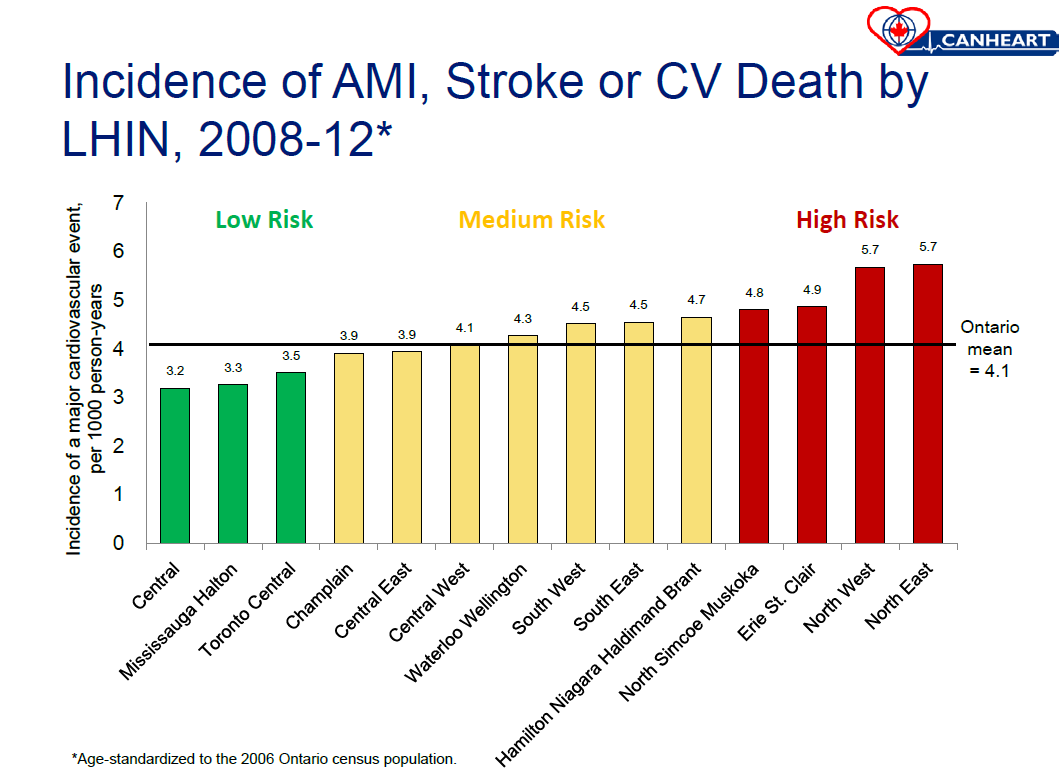If you live in Ontario, your risk of having a heart attack, stroke or dying of cardiovascular disease could depend on where you live in the province, a new study says.

According to the Institute for Clinical Evaluative Sciences (ICES) and the Sunnybrook Schulich Heart Centre, the region in which patients live can determine how likely it is they receive preventative heart health care and whether they’ll suffer such adverse cardiovascular events.
“We did a study to look at regional variations across Ontario LHINs (Local Health Integration Networks) in terms of the likelihood of people developing heart attacks, stroke or cardiovascular death,” lead author Dr. Jack Tu says. “We then did a detailed analysis to try and identify what was driving those variations and it looks like there are three important factors.”
READ MORE: Yo-yo dieting could lead to heart disease-related death: study
Those three factors were:
- Health behaviours (like smoking and obesity rates).
- Ethnic variations and socio-economic status.
- Health system factors (like access to family doctors and screening for cardiac risk factors).
Tu and the research team looked at 5.5 million adults between the ages of 40 and 79 as of Jan. 1, 2008 in Ontario who had no previous cardiovascular disease. They followed them for five years looking for heart attacks, strokes or deaths due to cardiovascular disease.
- Buzz kill? Gen Z less interested in coffee than older Canadians, survey shows
- ‘She gets to be 10’: Ontario child’s heart donated to girl the same age
- Canada updating sperm donor screening criteria for men who have sex with men
- Bird flu risk to humans an ‘enormous concern,’ WHO says. Here’s what to know
That’s when they found cardiovascular event rates had a near two-fold difference across the province’s 14 LHINs from 3.2 to 5.7 events per 1,000 years.
The LHIN regions that had the fewest cardiovascular events were all located in the Greater Toronto Area.
They are the Central LHIN, Mississauga Halton LHIN and Toronto Central. They all also had the highest average number of family doctors visits, were more likely to get an annual physical and be screened for cardiac risk factors like high cholesterol and diabetes. The rate of diabetic patients with hypertension who controlled their blood pressure with statin use was also higher in the healthiest LHINs. These regions also had a high proportion of ethnic minority residents and recent immigrants.
The regions with a medium risk were the Champlain LHIN, Central East LHIN, Central West LHIN, Waterloo Wellington LHIN, South West LHIN, South East LHIN and Niagara Haldimand Brant LHIN.
The four LHINs that had the highest risk, however, were the North Simcoe Muskoka LHIN, Erie St. Clair LHIN, North West LHIN and North East LHIN. Those living in these LHINs were more likely to be obese, smoke and eat the least fruits and vegetables. They were also less likely to get preventative screening tests, have annual physicals and visited their family doctors less often.
“I think what was most surprising was the health system factors,” Tu said. “We knew going into the study that there are lifestyle differences but that only seemed to explain a third of the variation. What we found was that people who live in areas with the lowest instances of disease have the best health-care access, and the people who live in areas with the highest instances of disease have the least health-care access. So our health care is probably exacerbating these disparities rather than narrowing them.”
Tu says these disparities have existed within Ontario for at least the last 20 years. He adds that while the situation hasn’t gotten any better, the existence of these disparities also hasn’t been completely understood – and that’s a problem.
“We don’t know what’s driving it,” he said. “So before we can try to address this problem, we need to understand why such a big difference exists.”
READ MORE: Have high pain tolerance? Don’t ignore these signs of a ‘silent’ heart attack
Tu says he hopes people in high-risk areas will find ways to become more proactive in their heart health care, especially now that they know why they’re at a higher risk.
“We’d like to encourage people who live in high-risk areas to try and get better access to preventative health-care services – so being screened for diabetes, high cholesterol and high blood pressure. And if they do have these risk factors, making sure that they get treated and controlled as best as possible because we know all this can decrease the likelihood of them eventually suffering a heart attack or stroke.”
The study was published Monday in the Canadian Medical Association Journal (CMAJ).
According to the Heart and Stroke Foundation, there are 1.6 million Canadians living with heart disease and stroke.
Visualizations provided by the Institute for Clinical Evaluative Sciences (ICES) and the Sunnybrook Schulic Heart Centre.






Comments